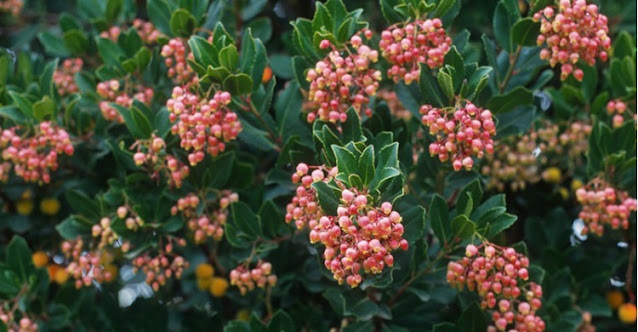 |
| Arbutus unedo 'Rubra' |
Arbutus unedo 'Rubra' is a large bushy evergreen shrub or small tree with rough bark and dark green leathery leaves. Commonly known as the 'pink strawberry tree', it is a naturally occurring variety which was first discovered by Scottish botanist William Aiton (1731–1793) in 1785. The type species was named and described by Carl Linnaeus (1707–1778) in Volume One of his landmark 1753 work Species Plantarum. William Aiton was responsible for naming the variety. The first recording of this natural variant growing in the wild in Ireland was in 1835, which is also the earliest known date of its cultivation.
Under favourable conditions, Arbutus unedo 'Rubra' will reach a height and spread of approximately 6 metres It has attractive glossy evergreen leaves
It is noted for it rosy-pink urn-shaped flowers which are produced in panicles in the autumn. Red, strawberry-like fruits will ripen at the same time, although a result of the previous years blooms.
Arbutus unedo 'Rubra' will be happy growing in any non alkaline, fertile, moist but free draining soil. Yet despite its Ericaceae family classification, it has been proven to be one of the most tolerant of all the genus of alkaline conditions, even growing on chalk. When planting into heavy or poorly drained soils, dig in plenty of well-rotted farm manure or garden compost beforehand.
Young specimens are less resilient from the cold than mature plants and are prone to damage in freezing conditions. With that in mind, provide a sunny, sheltered position that will protect your Arbutus unedo 'Rubra from cold northerly and easterly winds. Other than in the mildest regions of the United Kingdom, provide additional winter protection for the first few years. Mulch in the spring, but avid it touching the trunk.
Arbutus unedo 'Rubra' gained the Royal Horticultural Society's Award of Garden Merit (AGM) in 1984, the Award of Merit in (1925).
Under favourable conditions, Arbutus unedo 'Rubra' will reach a height and spread of approximately 6 metres It has attractive glossy evergreen leaves
It is noted for it rosy-pink urn-shaped flowers which are produced in panicles in the autumn. Red, strawberry-like fruits will ripen at the same time, although a result of the previous years blooms.
Arbutus unedo 'Rubra' will be happy growing in any non alkaline, fertile, moist but free draining soil. Yet despite its Ericaceae family classification, it has been proven to be one of the most tolerant of all the genus of alkaline conditions, even growing on chalk. When planting into heavy or poorly drained soils, dig in plenty of well-rotted farm manure or garden compost beforehand.
Young specimens are less resilient from the cold than mature plants and are prone to damage in freezing conditions. With that in mind, provide a sunny, sheltered position that will protect your Arbutus unedo 'Rubra from cold northerly and easterly winds. Other than in the mildest regions of the United Kingdom, provide additional winter protection for the first few years. Mulch in the spring, but avid it touching the trunk.
Arbutus unedo 'Rubra' gained the Royal Horticultural Society's Award of Garden Merit (AGM) in 1984, the Award of Merit in (1925).
For related articles click onto the following links:







No comments:
Post a Comment